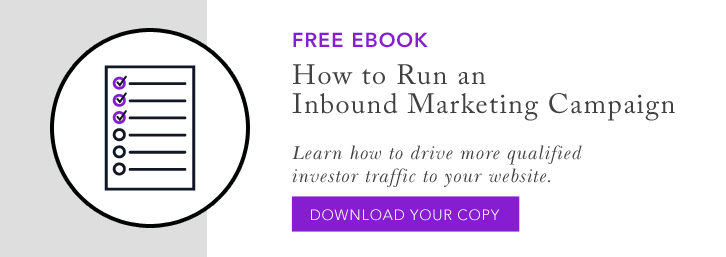Investment Advisor Marketing, Step 1: It’s Time to Hyper-Personalize Your Emails
Email personalization is all grown up. This is important to understand, because adding personalization tokens to your marketing emails is a smart and fairly simple step in a good investment advisor marketing plan. But it’s not just a matter of adding “Dear <FirstName>” to your emails anymore.
Sure, personalized subject lines increase open rates by about 26 percent, according to Experian. But sticking the recipient’s name in the subject line is just scratching the surface of how modern technology is transforming financial advisor marketing.
Financial advisors are competing for leads. And with the vast amount of information investors can find online today, attracting those leads has become a tougher task. Investment advisor marketing plans need to step up their game to compete. Those who master email personalization will have a decided marketing advantage.
Hyperpersonalization is more than just cramming the recipient’s name into the emails. It’s the difference between being product-centered or advisor-centered in your communications and being customer-centered.
Personalization Means Segmenting
Financial advisors who aren’t segmenting their leads have already fallen behind. By doing this, you can deliver messages tailored to each contact.
Once you segment your leads, you can personalize your communication to better connect with a specific lead.
For example, segmenting means you know that middle-aged men with good jobs buy sports cars. Further personalization can happen when you know that middle-aged man has already been reading Car & Driver reviews on his phone and he walked through the Porsche lot yesterday on his lunch hour.
Personalization Stats
Personalized, triggered e-mails based on actual individual consumer behavior command three times better results than “batch and blast” emails directed at demographic segments, according to Marketo.
According to Dynamic Yield, 62 percent of North Americans surveyed said they are more likely to open and respond to an email that looks like it was written specifically to them.
A study from Experian showed that personalized emails generated six times the transaction rate of non-personalized emails. The firm also found that personalized emails generated unique click rates that were 41 percent higher than non-personalized emails.
Today’s investment advisor marketing tools make it easy to set up hyper-personalized, individualized communications that were unheard of just a few years ago. Companies are generating increased engagement by crafting personalized messages using the following data points:
- Name
- Social media information
- Age
- Gender
- Time of day
- Call history
- Previous interactions and purchases
- Review history
- Geography
- Profession
- Assets
- Web browsing history
- Reading preferences
Use Caution
Financial advisors who are using smart email personalization strategies and other communication tools should ensure they don’t sabotage themselves with clumsy messaging. For example, companies have been sending emails and coupons for holidays for years. But if you don’t understand the significance of a given holiday and its practices, you can cause yourself a lot of embarrassment with an email message like “Dear Joe: Happy Yom Kippur!”
When companies get it wrong, it’s worse than not using any personalization at all.
Working with a marketing firm with expertise in the financial services field can help you avoid these mistakes. Many marketing firms aren’t aware of financial-specific practices, terminology and schedules and may turn clients off with an uneducated email.
Automation is Key
Your personalization is only as good as your database. If you’re keeping your client list all in your head, you’re already limiting yourself. If you’re a small firm, you may have a decent sense about the personal situations of each of your existing clients. But relying on your own memory and writing out each personalized email one at a time is a great way to stay small.
To grow, you should be marketing to prospects and not just current clients.
Visible and Invisible Personalization
Personalization can be invisible, too. For example, today’s technology can see individual prospect behavior, and via predictive analytics, figure out what your targeted reader is most likely to respond to based on their own individual behavior.
Website analytics can not only track what messaging an individual user is likely to respond to, but are starting to be able to tell things like what time of day an individual opens or clicked through previous emails. Using that knowledge, financial advisors can then automatically time future emails so their message is at the top of the queue, arriving just before the recipient has historically opened past emails.
All the while, modern email technology is automating segmentation processes that were, until very recently, entirely manual.
Integrating Personalization With Your Website
A good website should generate leads. For example, you may have a series of white papers on specific topics that matter to your target market, but you could develop a series of pieces on distinct topics and capture an email address for each content piece the reader downloads.
Over time, you will have a growing list of emails that you can map to specific topics. Depending on what offer your lead opted for, you will learn what he or she is interested in and what the pain points are. You can then use this information to send them something they will be interested in, such as a recent blog post.
Each piece of information that you can gather from a potential client can be used as the basis for further marketing, and allows you to send your lead what they’re looking for.
Turn an Interested Reader Into a Prospect
Here’s another example:
You have a visitor to your website who took a full four minutes to read one of your blog posts. He then clicked over to another blog post and spent two or three minutes there before clicking away. That’s a hot prospect, and he clearly finds value in your message. Otherwise, he’d have bounced off your site in seconds.
If you can get that lead to opt in to communications from you, you can send them a personalized behavior-based trigger email the next day, reminding them about the pieces they read from your blog and move them down the sales pipeline.
Taking that idea a step further:
Say you have a reader who clicks on three blog articles in a row about tax planning. You know that’s a hot-button issue for that individual. You can then add that individual in a queue to receive several specific messages from you:
- A message in late November, reminding them of the importance of year-end tax planning
- A message in February, detailing commonly overlooked tax deductions
- A message in April, detailing last-minute filing tips
- Messages throughout the year based on legislative developments, new tax laws and general tax planning topics
In short, integrating your web content strategy with individualized, personalized emails based on the revealed preferences of a specific individual and not just a demographic allows you to create and automate a full-fledged targeted drip-marketing campaign.
Best Practices
Here are some investment advisor marketing best practices:
- Include an unsubscribe link in all communications.
- Don’t rely on list brokers. Lists that you buy from a list broker are far, far inferior to lists you can develop yourself via a comprehensive Inbound Marketing strategy.
- Include a way for readers to set their own preferences. If they open your email, ask them what topics they want to hear about. Give them a brief checklist and import their responses into your marketing database. This is particularly effective for newsletter and white paper subscribers. They already believe you will be adding value, or they wouldn’t be subscribing in the first place.
Lastly, and most importantly, work with a professional marketing firm like Paladin Digital Marketing that has the right expertise in your industry. Outsourcing these tasks may seem like a big cost up front, but over time, relying on an expert to handle these tasks, which will require a lot of time and therefore money if you try to tackle them yourself, will be a cost-savings move in the long run.


